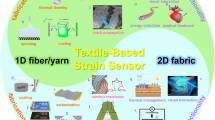Abstract
This paper describes the design and characterization of a micro-electro-mechanical systems tri-axial force sensor that can be mounted on the tip of an 1-French guidewire (0.014″). Piezoresistive silicon nanowires (SiNWs) are embedded into four beams forming a cross-shape to allow the detection of forces in three axes. The electrical resistance changes in the four SiNWs are used to decode arbitrary force applied onto the force sensor. Finite element analysis was used in the structural design of the force sensor. Robustness of the force sensor is improved due to the novel design of incorporating a mechanical stopper on the tip of the stylus. Flip chip bonding, using gold stud bumps, is used to mount the force sensor on a substrate for characterization and to simplify the assembly process. The sensor is robust enough to withstand normal forces higher than 20 gf. The proposed sensor can be used for new medical applications in vascular interventions and robotic surgeries.













Similar content being viewed by others
References
Asahi Intecc (2010) Medical products—PTCA guide wire, Web: http://www.asahi-intecc.com/medical/international/product/ptca_gw.php. Accessed 25 Sep 2010
Beccai L, Roccella S, Arena A, Valvo F, Valdastri P, Menciassi A, Carrozza MC, Dario P (2005) Design and fabrication of a hybrid silicon three-axial force sensor for biomechanical applications. Sensor Actuat A-Phys 120:370–382
Beyeler F, Muntwyler S, Nelson BJ (2009) A six-axis MEMS force-torque sensor with micro-Newton and nano-Newtonmeter resolution. J Microelectromech S 18:433–441
Bonanomi G, Rebello K, Lebouitz K, Riviere C, Di Martino E, Vorp D, Zenati MA (2003) Microelectromechanical systems for endoscopic cardiac surgery. J Thorac Cardiovasc Surg 126:851–852
Fahlbusch, S, Fatikov S, Santa K (1998) Force sensing in microrobotic systems: an overview. In: IEEE International Conference on electronics, circuits and systems, pp 259–262
Jin WL, Mote CD (1998) Development and calibration of a sub-millimeter three-component force sensor. Sensor Actuat A-Phys 65:89–94
Neuzil P, Wong CC, Rebound J (2010a) Electrically controlled giant piezoresistance in silicon nanowires. Nano Lett 10:1248–1252
Neuzil P, Shah D, Herrera C, Jais P, Hindricks G, Natale A, Fonck E, Lambert H, Kuck KH, Reddy V Y (2010b) Does catheter contact force during RF ablation relate to AF recurrence rate? In: Proc. of Cardiostim, Nice, France, pp 176–177
Petersen KE (1998) Silicon as a mechanical material. Proc IEEE 70:420–457
Rebello KJ (2004) Applications of MEMS in surgery. Proc IEEE 92:43–55
Rowe ACH (2008) Silicon nanowires feel the pinch. Nat Nanotechnol 3:311–312
Smith CS (1954) Piezoresistance effect in germanium and silicon. Phys Rev 94:42–49
Takizawa H, Tosaka H, Ohta R, Kaneko S, and Ueda Y (1999) Development of a microfine active bending catheter equipped with MIF tactile sensors. In: Proc 12th IEEE Int. Conf. Micro Electro Mechanical Systems (MEMS’99), pp 412–417
Tibrewala A, Phataralaoha A, Buttgenbach S (2008) Analysis of full and cross-shaped boss membranes with piezoresistors in transversal strain configuration. J Micromech Microeng 18:1–6
Tonino PAL, De Bruyne B, Pijls NHJ et al (2009) Fractional flow reserve versus angiography for guiding percutaneous coronary intervention. New Engl J Med 360:213–224
Valdastri P, Harada K, Menciassi A, Beccai L, Stefanini C, Fujie M, Dario P (2006) Integration of a miniaturised triaxial force sensor in a minimally invasive surgical tool. IEEE Trans Bio-Med Eng 53:2397–2400
Valdastri P, Houston K, Menciassi A, Dario P (2007) Miniaturized cutting tool with triaxial force sensing capabilities for minimally invasive surgery. J Med Devices 1:206–211
Acknowledgments
This work was supported in part by A*Star science and research council under Grant 0921480070. Authors would like to thank the support from Dr. Benjamin SY Chua, and Dr. C.N. Lee of the National University of Singapore, Department of Surgery.
Author information
Authors and Affiliations
Corresponding author
Additional information
W-T Park and R. Krishna Kotlanka contributed equally as first author.
Rights and permissions
About this article
Cite this article
Park, WT., Kotlanka, R.K., Lou, L. et al. MEMS tri-axial force sensor with an integrated mechanical stopper for guidewire applications. Microsyst Technol 19, 1005–1015 (2013). https://doi.org/10.1007/s00542-012-1691-x
Received:
Accepted:
Published:
Issue Date:
DOI: https://doi.org/10.1007/s00542-012-1691-x




